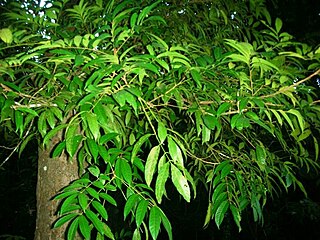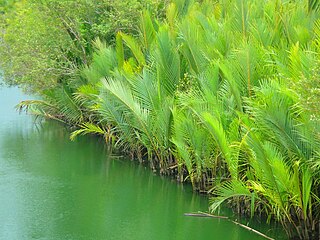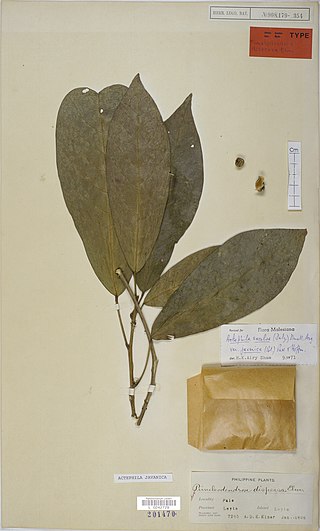
The tembusu is a large evergreen tree in the family Gentianaceae, native to Southeast Asia. It is the Malay name for Cyrtophyllum fragrans.

Aglaia lawii is a species of tree in the family Meliaceae. As well as the autonym species, there are two subspecies accepted.
Aglaia leptantha is a species of tree in the family Meliaceae. It is found in Mainland and Island Southeast Asia. People use the plant for food, incense, and for human and bovine medicine. Gibbons also eat parts of the tree.

Aglaia spectabilis is a species of tree in the family Meliaceae, found from the Santa Cruz Islands in the southwest Pacific to Queensland (Australia), Southeast Asia, Yunnan (Zhōngguó/China) and the Indian subcontinent. It grows from a 1m shrub to an emergent 40m tall tree, depending on the habitat. Its wood is commercially exploited as timber, but otherwise is of poor quality with limited use. The fruit are eaten, and used in folk medicine. The seeds are large in comparison to other plants, and a major source of dispersal of the species are hornbills eating the fruit, flying away from the tree and regurgitating the seeds.It is also found in Assam, India

Fagraea is a genus of plants in the family Gentianaceae. It includes trees, shrubs, lianas, and epiphytes. They can be found in forests, swamps, and other habitat in Asia, Australia, and the Pacific Islands, with the center of diversity in Malesia.

Campylospermum serratum is a plant in the family Ochnaceae. The specific epithet serratum is from the Latin meaning "with teeth", referring to the leaf margin. It is found in Tropical Asia, from Sulawesi, Indonesia to Hainan, Zhōngguó/China and over to southwester India. Gomphia serrata was a previous common name for the species. The plant is used for it wood and its sap is used in folk medicine and in the past for teeth-blackening.

Dipterocarpus alatus, also known colloquially as the resin tree, is a tropical forest tree, of dense evergreen or mixed dense forests, in tropical Asia. It is considered vulnerable.

Nypa fruticans, commonly known as the nipa palm or mangrove palm, is a species of palm native to the coastlines and estuarine habitats of the Indian and Pacific Oceans. It is the only palm considered adapted to the mangrove biome. The genus Nypa and the subfamily Nypoideae are monotypic taxa because this species is their only member.

Lumnitzera racemosa, commonly known as the white-flowered black mangrove, is a species of mangrove in the family Combretaceae. It is found on the eastern coast of Africa and other places in the western Indo-Pacific region. It has one accepted variety from the noniminate species, Lumnitzera racemosa var. lutea (Gaudich.) Exell.

Actephila excelsa is a species of shrub in the family Phyllanthaceae. It is native to an area in Tropical Asia and Zhōngguó/China, from Sulawesi to India and Guangxi. It is a highly variable species and leaf forms vary across adjacent ecozones. The plant is used in building houses and as a vegetable. Grey-shanked douc langurs eat the leaves.
Aporosa ficifolia is a species of shrub in the family Phyllanthaceae. It grows 2-8m tall, it has a restricted habitat, growing in lowland open or pine forests up to 700m elevation.
Ardisia helferiana is a species of flowering plant in the genus Ardisia in the family Primulaceae. Growing as a shrub, it occurs in Mainland Southeast Asia. The plant is used for food, fuel and medicine.
Utania is a genus of flowering plants belonging to the gentian family (Gentianaceae), the tribe Potalieae, and the subtribe Potaliinae. A small genus it has 12 species.
Mallotus floribundus is a tree in the family Euphorbiaceae, in the Stylanthus section, native to Southeast Asia, Wallaceae, New Guinea and the Solomon Islands.
Spathiostemon moniliformis is a plant that can grow as a shrub or a tree in the Euphorbiaceae family, Acalypheae tribe. It is endemic to southern/peninsular Thailand.
Memecylon caeruleum is a shrub or tree species in the Melastomataceae family. It is found from New Guinea, west through Southeast Asia to Tibet, Zhōngguó/China. It has become an invasive weed in the Seychelles. It has some local use for wood and food.

Syzygium claviflorum is a tree in the Myrtaceae family. It is native to the north of the Australian continent and in tropical and subtropical Asia. It is used for timber, as fuel, as human and cattle food, and for dye. Stunted specimens can be found on the top of the plateau of Bokor National Park, Cambodia.

Xanthophyllum lanceatum is a tree in the Polygalaceae family. It grows across Southeast Asia from Sumatera to Bangladesh. The leaves are used as a hops-substitute in beer making and the wood as fuel. Fish in the Mekong regularly eat the fruit, flowers and leaves.

Aporosa octandra is a species of plant in the family Phyllanthaceae found from Queensland and New Guinea to Indonesia, Zhōngguó/China and India. It is a highly variable plant with 4 named varieties. Its wood is used in construction and to make implements, its fruit is edible. The Karbi people of Assam use the plant for dyeing, textile colours have quite some significance in their culture.
Memecylon lilacinum is a tree species in the Melastomataceae family. It is usually an understorey species in closed forests. It is native to an area of tropical Asia, from Jawa to Philippines to Vietnam and the Andaman Islands and Myanmar. It is a food plant for the macaque Macaca facsicularis and a bee in the Megachilidae family.











